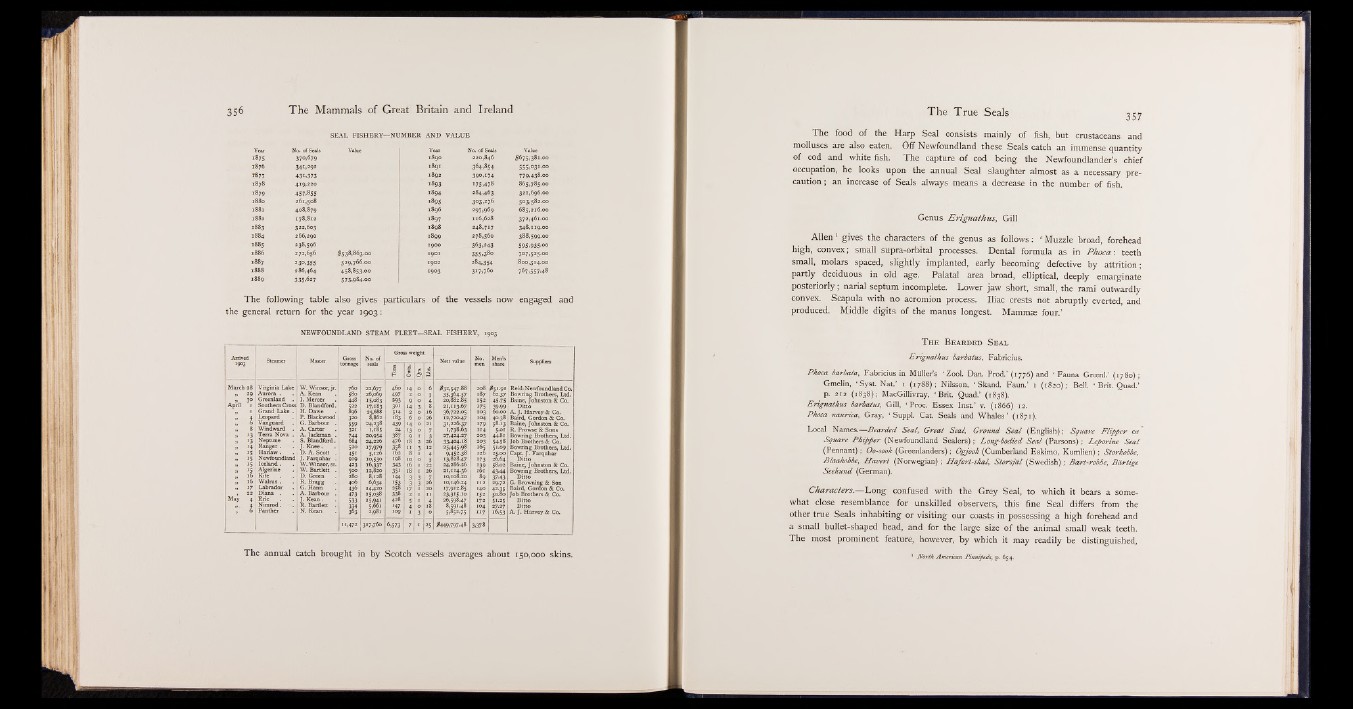
SEAL FISHERY— NUMBER AND VALUE
Year No. of Seals Value Year No. of Seals Value
1875 370,679 1890 220,846 #675,381.00
1876 341,292 1891 364,854 555,O3I-0O
T877 431.373 1892 390.174 779,438.00
1878 419,220 1893 175,478 865,785.00
1879 457.855 1894 284,463 321,696.00
1880 261,508 1895 303,276 503,582.00
1881 . 408,879 1896 297,969 685,216.00
1882 178,812 1897 116,628 372,461.00
1883 322,603 1898 248,717 348,119.00
1884 266,290 1899 278,560 388,599.00
1885 *38,596 1900 363,*43 595,935-00
1886 272,656 #538,863.00 1901 355,380 707,525.00
1887 *30.355 529,766.00 1902 *84,354 800,3x4.00
1888 286,464 458,853.00 1903 317,760 767,557-48
1889 335.6*7 573,984-oo
The following table also gives particulars of the vessels now engaged and
the general return for the year 1903:
NEWFOUNDLAND STEAM FLEET—SEAL FISHERY, 1903
The annual catch brought in by Scotch vessels averages about 150,000 skins.
The food of the Harp Seal consists mainly of fish, but crustaceans and
molluscs are also eaten. Off Newfoundland these Seals catch an immense quantity
of cod and white fish. The capture of cod being the Newfoundlander’s chief
occupation, he looks upon the annual Seal slaughter almost as a necessary precaution
; an increase of Seals always means a decrease in the number of fish.
Genus Erignatkus, Gill
Allen 1 gives the characters of the genus as follows: ‘ Muzzle broad, forehead
high, convex; small supra-orbital processes. Dental formula as in Phoccr. teeth
small, molars spaced, slightly implanted, early becoming defective by attrition;
partly deciduous in old age. Palatal area broad, elliptical, deeply emarginate
posteriorly; narial septum incomplete. Lower jaw short, small, the rami outwardly
convex. Scapula with no acromion process. Iliac crests not abruptly everted, and
produced. Middle digits of the manus longest. Mammae four.’
T h e B e a r d e d S e a l
Erignatkus barbatus, Fabricius.
Pkoca barbata, Fabricius in Muller’s ‘ Zool. Dan. Prod.’ (1776) and ‘ Fauna Green!.’ (1780);
Gmelin, ‘ S y s t Nat.’ 1 (1788); Nilsson, * Skand. Faun.’ 1 (1820); Bell. ‘ Brit. Quad.’
p. 212 (1838); MacGillivray, ‘ B rit Quad.’ (1838).
Erignatkus barbatus, Gill, ‘ Proc. Essex Inst.’ v. (1866) 12.
Pkoca naurica, Gray, ‘ Suppl. Cat. Seals and Whales’ (1871).
Local Names.— Bearded Seal, Great Seal, Ground S eal (English); Square Flipper or
Square Phipper (Newfoundland Sealers); Long-bodied Seal (Parsons); Leporine Seal
(Pennant); Oo-sook (Greenlanders); Ogjook (Cumberland Eskimo, Kumlien); Storkobbe,
Blaakobbe, Havert (Norwegian); H afert-skal, Storsjäl (Swedish); Bart-robbe, Bärtige
Seehund (German).
Characters.— Long confused with the Grey Seal, to which it bears a somewhat
close resemblance for unskilled observers, this fine Seal differs from the
other true Seals inhabiting or visiting our coasts in possessing a high forehead and
a small bullet-shaped head, and for the large size of the animal small weak teeth.
The most prominent feature, however, by which it may readily be distinguished,
North American Pinnipeds, p. 654.